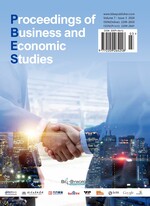Abstract
Work-for-relief plays a unique role in China’s journey toward modernization. From the perspectives of policy tools and interest analysis, this paper uses quantitative analysis of policy texts and integrates grounded theory to build a policy expression analysis model to discuss the current work-for-relief policy system. The study found that China’s use of the work-for-relief policy is unbalanced, and it is necessary to enhance the involvement of non-governmental sectors, as well as to fully consider the policy’s target groups and the social issues that need addressing.
References
Wang SY, Li X, Zhang XY, 2023, Research on the Self-Construction Model of Villagers with Work Relief from the Perspective of Rural Revitalization – Taking the Practice of Sichuan Province as an Example. Agricultural Economy, 2023(7): 72–74.
Fu Z, Guan JC, 2023, Exploration of the Promotion of Work-for-Relief Methods and Development Status in the Field of Forestry – Taking Guangxi as an Example. Rural Economy and Science and Technology, 34(9): 232–235.
Pang MH, 2022, Practice and Discussion on the Reform of Small Reservoir Management System in Anhui Province. JiangHuai Water Conservancy Technology, 2022(4): 11–13.
National Development and Reform Commission, 2020, Xinjiang Uygur Autonomous Region: Increasing Efforts in Work-for-Relief Programs to Aid the Decisive Victory in the Battle Against Poverty. China Economic & Trade Herald, 2020(33): 16–18.
Wang MJ, 2021, The Effectiveness, Issues, and Suggestions of New Work-for-Relief Measures in Guangyuan. China Economic & Trade Herald, 2021(12): 72–75.
National Development and Reform Commission, 2020, Guangshan County, Henan Province: Work-for-Relief Aids Poverty Alleviation, Innovates Mechanisms, and Promotes Rural Revitalization. China Economic & Trade Herald, 2020(34): 51.
National Development and Reform Commission, 2020, Yunyang District, Hubei Province: Work-for-Relief Plans for Project and Industry Development to Promote Income Growth. China Economic & Trade Herald, 2020(34): 43–44.
Luo H, Chen C, 2023, Grass-Root Officials Taking the Lead to Enhance Governance with Innovation – Canchong Village of Maoxian County Improving Grass-Root Governance with Villagers Implementing Relief for Work Projects. China Investment, 2023(Z7): 48–51.
Zhu L, 2021, Evolution of the Thought and Practice of Work-for-Relief. History of Economic Thought, 2021(4): 3–24.
Shen YT, 2018, Review of the Research on the Issue of Work Relief Based on the Research After the Founding of the People’s Republic of China. Journal of Harbin University, 39(1): 62–65.
Wang SC, 2022, How to Get Both “Fishing” and “Fish”? Policy Practice, Concept Connotation, and Enlightenment of Work Welfare. Comparison of Economic and Social Systems, 2022(5): 49–58.
Measures for the Administration of Work-for-Food, n.d., 2023. Gazette of the State Council of the People’s Republic of China, 1801(10): 24–30.
Yu HS, Zhou YY, 2022, Why Did Public Policy Fail? An Explanatory Model Based on the Perspective of Policy Subject. Zhejiang Social Sciences, 2022(3): 34–40 + 88 + 157.
Guo ZX, Zhang YL, 2022, Fuzzy Object, Flexible Space, and Strategic Policy Implementation – A Case Study of the Minimum Living Security Policy in N City. Learning and Practice, 2022(1): 88–97.
Feng J, Yang ZY, 2009, Analysis of Public Policy Process from the Perspective of Interests. Administration in China, 2009(1): 26–30.
Zheng XR, Yu S, 2021, Audit Research on Public Policy Effect. Audit Research, 2021(1): 11–18.
Landis JR, Koch GG, 1977, The Measurement of Observer Agreement for Categorical Data. Biometrics, 33(1): 159–174.
Rothwell R, Zegveld W, 1984, An Assessment of Government Innovation Policies. Review of Policy Research, 3(3–4): 436–444. https://doi.org/10.1111/j.1541-1338.1984.tb00138.x
Wang PQ, Lai XJ, 2013, A Study on the Model and Mechanism of Public Policy Diffusion in China. Journal of Peking University (Humanities and Social Sciences ), 50(6): 14–23.
Hong MY, Lou L, Gong LJ, 2022, Poverty Governance with Chinese Characteristics: Institutional Basis and Theoretical Interpretation. Journal of Shandong University (Philosophy and Social Sciences Edition), 2022(2): 23–37.
Liu X, 2000, An Analysis of the Unbalanced Distribution of Benefits and Costs in Public Policy. Exploration, 2000(2): 48–51.
Ding H, Yang DF, 2009, Perspectives, Research Approaches, and Model Construction for the Selection of Policy Tools. Administrative Forum, 16(3): 21–26.
Tang LX, Zhang YK, 2019, From Work Relief to Public Welfare Position – The Evolution of China’s Work Welfare Practice. Guizhou Social Sciences, 2019(12): 147–153.
Xu TJ, 2021, The Role and Development of “Work-for-Relief” from the Perspective of Economics. China Management Informatization, 24(3): 192–194.
Zhu YT, 2022, Functional Evolution and Application of the Work Relief System. Journal of Heilongjiang Institute of Engineering, 36(1): 66–70.
Chen JX, 2020, International Experience of Social Policy Targeting Mechanism – Taking the Employment Assistance Policies of Germany, the United States, and Japan as Examples. Employment and Security, 2020(23): 31–32.
Guan XP, 2022, Improving the Multi-Layer Targeting Mechanism of China’s Social Assistance System. Inner Mongolia Social Sciences, 43(2): 139–146 + 2.
Liu HQ, Liang YC, 2021, Influence Mechanism of Policy Content Reproduction-Research Based on Agricultural Policy Texts. Sociological Research, 36(1): 115–136 + 228–229.
